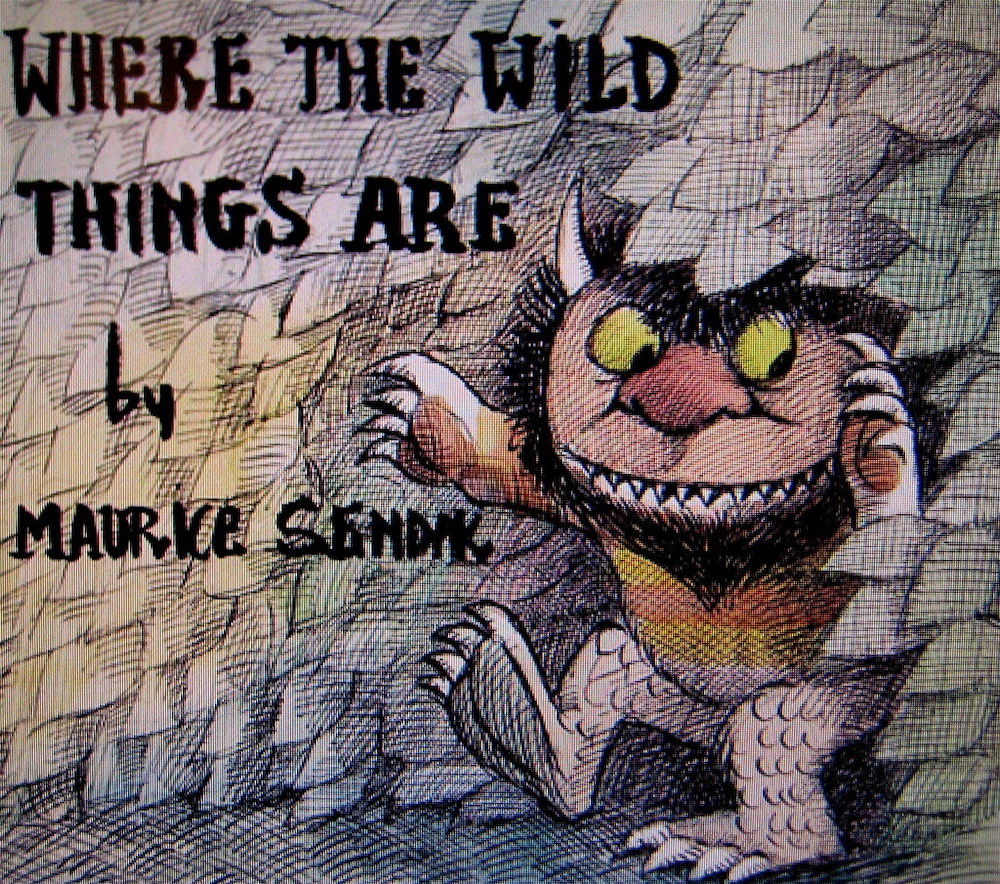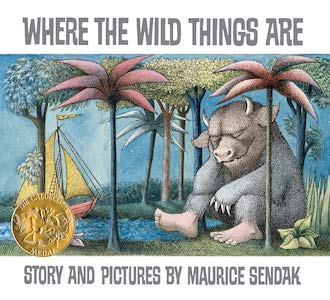Electric Lit is 12 years old! Help support the next dozen years by helping us raise $12,000 for 12 years, and get exclusive merch!
Maybe you’re familiar with this story: A young boy in a white wolf costume is sent to his room after he runs around the house, terrorizing his family, screaming at his mother, “I’LL EAT YOU UP!” After being sent to bed with no dinner, the boy finds himself in a strange new world, filled with vines and trees and terrible creatures he calls the “Wild Things.” He becomes the king, the wildest thing of them all.
When Where the Wild Things Are was first published in 1963 by what was then Harper & Row Books, no one predicted how it would take the world of children’s literature by storm. Adults were puzzled as their children, once reluctant readers, dragged them to the library over and over again to read this story, one that was unlike any other at the time. Within the realm of children’s books, a space previously marked by the conservative, didactic messaging of Dick and Jane stories, Sendak was a breath of fresh air, having written a child protagonist who was as messy and loud and chaotic as he longed to be.
Maurice Sendak broke new literary and artistic ground by turning to the darker realities of childhood, illustrating a blend of anger, frustration, and other complicated emotions among the monsters he painted. Rather than patronizing his young readers, painting an illusion of childhood “innocence,” he respected them by acknowledging the terrifying reality of what it meant to be a child, someone who existed on the margins of life, who possessed both intense vulnerability and incredible insight, unfiltered by adult biases. Sendak, along with literary innovator and legendary editor Ursula Nordstrom, created a book that would become emblematic of the richness and depth of children’s picture books. He explored his own past, and mined and reflected upon his own experiences as a queer, Jewish child learning to grow up in the world. Sendak was, himself, the real deal “wild thing.”
Born and raised in Brooklyn, New York to Jewish Polish immigrant parents, Sendak occupied an “outsider” status in multiple senses of the word. Whether it was a physical “outsidership,” gazing upon the world outside from his bedroom window while sequestered from illness as a child in his home, or an internal one as the descendent of immigrant Holocaust victims and a gay adolescent in an extremely heteronormative world, Sendak could never quite blend into 20th century America’s idea of “normal.”
Sendak was, himself, the real deal ‘wild thing.’
While it is debatable how early Sendak became aware of his own queerness, he understood how his “difference” was perceived by others, saying in an interview, “You know what they all thought of me: sissy Maurice Sendak.” In addition to his attraction to men, Sendak’s natural early queer sensibilities—including his love for art and storytelling, as well as his physical departure from the Western athletic masculine ideal defined by Superman (whose Jewish immigrant/refugee origins have often been erased or “goy-washed” by American media)—created a sense of unease and “otherness” that carried into his work.
It should be noted that when it comes to fantasy and speculative fiction, queer readers and writers have always gravitated toward this medium. For instance, in an interview with Geeks OUT, author and illustrator, Ethan M. Aldridge (Estranged series) states:
There are so many themes and tropes in fantasy that resonate with the queer experience; outsiders finding their way through a strange world, transformations, hidden identities. People find impossible loves, change form and gender, escape from inescapable isolation into a world wider and more strange than they ever imagined. Fantasy is all about a life and a world outside of what we are told is possible, and I think that sense is something that speaks to a lot of queer people. We grew up with those feelings in us, so we gravitated to the stories that told us those feelings meant something true and important and beautiful. From changelings to voiceless mermaids to love-lorn princesses locked away in remote towers, queer people have been using fantasy as a way to express feelings of queerness for a long time.
While Max isn’t explicitly queer in the sense of sexuality or gender exploration, his “queerness” may refer to the older 19th century definition of queer as something “strange” or “peculiar.” As we see in Where the Wild Things Are, Max is considered a stranger to his own family. He is “cast out,” banished to his room for excessive and wild behavior. And like Dorothy Gale from The Wizard of Oz (another icon of children’s media that maintains a significant queer following), Max finds himself in a wonderland that simultaneously terrifies and welcomes. It is in the land of the Wild Things where Max finds the space to experiment, identify, and play. He learns how to be a new version of himself, braver and louder than he was ever allowed to be at “home,” while finding a new sense of self and chosen family—an also inherently queer theme— along the way.
It is in the land of the Wild Things where Max finds the space to experiment, identify, and play.
And speaking of family, like Sendak’s queerness, and his own familial roots, his Jewishness is something also inherently inescapable from his work. As an artist, Sendak frequently turned to his family for inspiration, even modeling the faces of his characters after the ancestors he found in family photo albums. This is seen in his illustrations for Zlateh the Goat and Other Stories, a collection of stories by the Jewish writer Isaac Bashevis Singer.
Yet the inspiration did not stop at transcribing from photos. Sendak also drew symbolically from his family, modeling his Wild Things after his Old World Yiddishist immigrant relatives.
In the piece titled “Moby Dick, Creativity, and Other Wild Things,” Sendak describes a typical day with his family:
They were a huge bunch who would roughly snatch you up at any moment. They’d jabber loudly in a foreign tongue—kiss, pinch, maul, and hug you breathless, all in the name of love. Their dread faces loomed—flushed, jagged teeth flaring, eyes inflamed, and great nose hairs cascading, all oddly smelly and breathy, all dangerous, all growling, all relatives.
In writings such as this, readers can see an obvious connection between the creatures in Max’s story and the “Wild Things” in Maurice’s life, otherwise known as his relatives. If you’ve ever had a relative come up to you and say something along the lines of, “you’re so cute, I could just eat you up!” then you’ve encountered a very Sendakian line of thought, a familial love that is both overwhelming and consuming (sometimes even literally). Yet in early 20th century America, when the model of the emotionally bland nuclear family was aggressively showcased, and conservative assimilation meant purging many “ethnic” modes of family behavior and flavor, Sendak’s family’s vibrant Jewish distinctiveness was likely considered “non-normative.” Perhaps his relatives’ own aggressive mannerisms and affections could even be mistaken for monstrosity.
Golan Y. Moskowitz, literary scholar and author of Wild Visionary: Maurice Sendak in Queer Jewish Context, had this to write about Sendak’s family: “In their inability to express love without eliciting terror, the Wild Things, whom Sendak called ‘foreigners, lost in America, without a language,’ are also like queer people experiencing love and attraction in ‘wrong’ ways, according to a prejudiced society.” In the context of xenophobia, antisemitism, and queerphobia, the different elements of Sendak’s life, the ones he himself regarded with both exasperation and deep love, were demonized, lending further weight to the sense of the “other” encountered in his stories.
Within children’s literature, there’s often a legacy of depicting marginalized groups as monsters, symbolic liminality illustrating the emblematic “other.” A more obvious example of this can be seen within early fairy tales. In her piece “Can I Still Love the Antisemitic Fairy Tales That I Grew Up With?“, Jewish writer Aleksia Mira Silverman notes that many of the classic Grimm Brothers’ stories she grew up with and loved contain a hostile legacy, writing, “I struggle to reconcile how much I love Grimms’ fairy tales with their reliance on antisemitic tropes and the deadly impact they’ve had on Jewish communities throughout history.” Taking in the archetypical witch model within the illustrations of many children’s books and fairy tales, it’s easy to identify the antisemitic tropes taking center stage: the curved noses, the wild, frizzy hair, all of which are classically stereotyped features for Ashkenazic Jewish women.
Consuming these narratives in story after story, it’s no wonder how any child lacking fair skin, reading how their other features, like hair and noses, are described as ugly and evil, might internalize feeling like a monster. Yet there are those like Sendak who have seen this wildness, this “monstrosity,” and turn towards it with compassion and empathy. Unlike most fairy tale stories, where those marked as “other” or different are considered the villains, in Sendak’s stories those marked as the “other” are capable of both loving and receiving love in return. As we see in Where the Wild Things Are, the Wild Things don’t hurt Max, but instead play with him, joining him in a “wild rumpus.” And toward the end of the book, when Max feels ready to return home, his mother, originally presented as the most antagonistic force in the story, is shown to contain multitudes. She leaves a warm meal waiting for her child. And what’s more Jewish than food as a symbol of our love?
And what’s more Jewish than food as a symbol of our love?
In their book, Craft in the Real World: Rethinking Fiction Writing and Workshopping, writer Matthew Salesses writes: “To be a writer is to wield and to be wielded by culture. There is no story separate from that. To better understand one’s culture and audience is to better understand how to write.” Salesses believes the act of writing is never created in an apolitical or neutral vacuum. It is never fully separate from the elements that affect our own lives and stories. While this does not mean every writer’s story is based on their life story, i.e., sometimes a story about talking cars is just about a story about talking cars, it would be limiting to say there is never any influence at all.
Growing up, one of the most useful lessons I learned came from a teacher who suggested that when reading, one should always turn to the back of the book and read the author’s page first. I was initially puzzled by this, wondering how knowing about the author in real life had anything to do with reading their work. Yet over the years, as I learned more about myself as a writer, I also started to learn to read between the lines. By doing so, I saw the richness of the stories I was reading, and the richness of where these stories came from. Sendak’s complicated and intersecting identities are intimately tied to his work as an artist. At the heart of Where the Wild Things Are lies Sendak’s heart: a boy like Max who was pulled between worlds, between his old Yiddishist Jewish immigrant heritage and the hostile, homophobic American landscape he was navigating. He embraced those who were considered “monsters” by the outside world, and in them he found his chosen family. He taught an entire generation that “wildness” need not be tamed by the artificial boundaries of society—that children like Max could simply be themselves, wild hearts and all.

